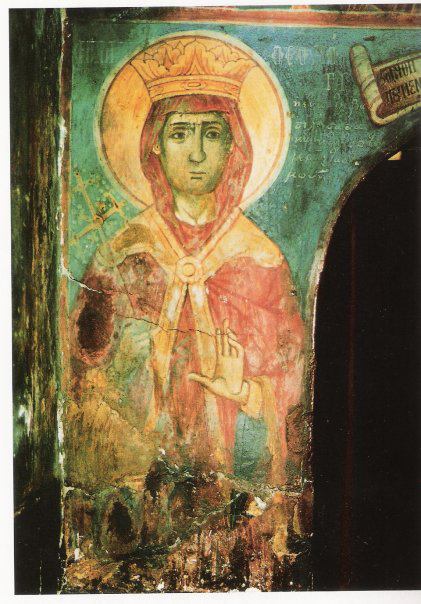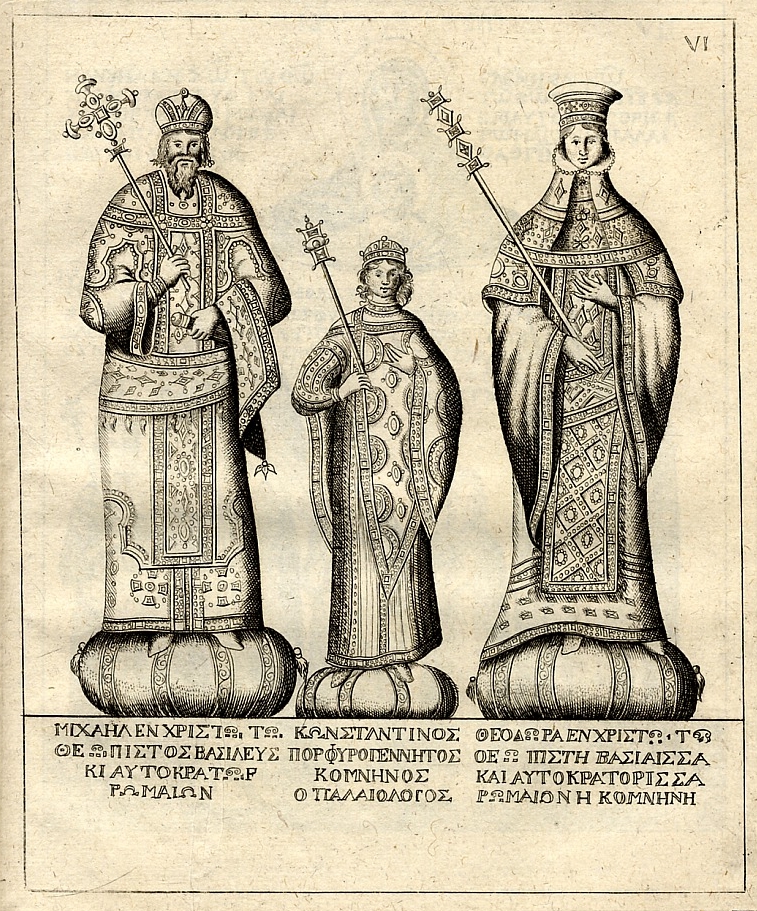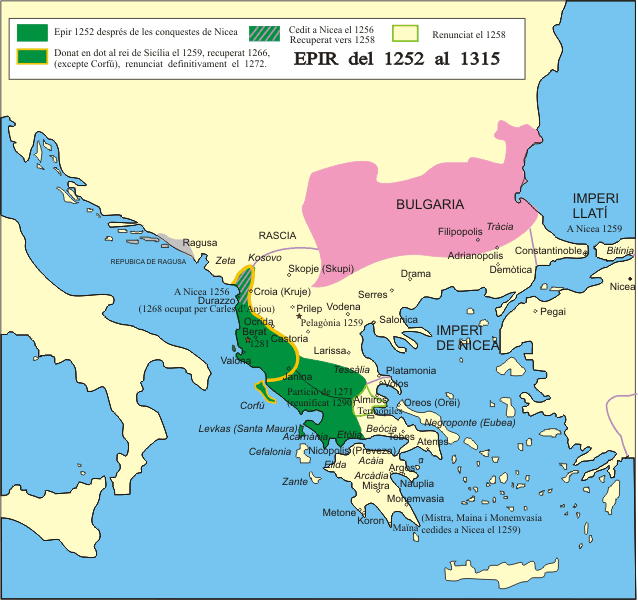|
Theodora Of Arta
Theodora Petraliphaina ( el, ОҳОөОҝОҙПҺПҒОұ О ОөП„ПҒОұО»ОҜПҶОұО№ОҪОұ), canonized as Saint Theodora of Arta ( el, О‘ОіОҜОұ ОҳОөОҝОҙПҺПҒОұ П„О·ПӮ ОҶПҒП„ОұПӮ; ca. 1225 вҖ“ after 1270), was a consort of Epirus and an Orthodox Christian saint. Life Her life is known mostly from a short hagiography written by the monk Job, sometimes identified with the late-13th century cleric Job Iasites. In view of the many chronological and genealogical errors however, this identification is open to question. Theodora was the daughter of the ''sebastokrator'' John Petraliphas, governor of Thessaly and Macedonia. She was born in Thessaloniki sometime between 1210 and 1216, and married Michael II Komnenos Doukas, the ruler of Epirus and Thessaly shortly after his accession in 1231, while still a child.Kazhdan (1991), p. 2038 Despite her being pregnant with Michael's son Nikephoros, she was soon banished from the court by her husband, who preferred to live with his mistress. Living in poverty, ... [...More Info...] [...Related Items...] OR: [Wikipedia] [Google] [Baidu] |
Agia Theodora Of Arta Fresco
Agia, ayia, aghia, hagia, haghia or AGIA may refer to: *''Agia'', feminine form of ''Agios'', 'saint' Geography * Agia, Cyprus * Agia, Chania, a town in Chania (regional unit), Crete, Greece *Agia, Larissa, Greece *Agia (Meteora), a rock in Thessaly, Greece * Agia, Parga, a town in Parga, Epirus Other uses *Saint Agia Aye (died c. 711) is a Belgian Catholic saint. She has been referred to also as Aia, Aya, Agia, and St. Austregildis. She is sometimes confused with another St. Agia, the mother of the French Saint Lupus of Sens, Loup of Sens. Aye is revered by ... (died c. 711), Belgian Catholic saint also known as Aye * Alaska Gasline Inducement Act, Alaskan State law * ''Agia'' (moth), a synonym of the moth genus ''Acasis'' See also * * * * {{disambig, geo ... [...More Info...] [...Related Items...] OR: [Wikipedia] [Google] [Baidu] |
Byzantine Empire
The Byzantine Empire, also referred to as the Eastern Roman Empire or Byzantium, was the continuation of the Roman Empire primarily in its eastern provinces during Late Antiquity and the Middle Ages, when its capital city was Constantinople. It survived the fragmentation and fall of the Western Roman Empire in the 5th century AD and continued to exist for an additional thousand years until the fall of Constantinople to the Ottoman Empire in 1453. During most of its existence, the empire remained the most powerful economic, cultural, and military force in Europe. The terms "Byzantine Empire" and "Eastern Roman Empire" were coined after the end of the realm; its citizens continued to refer to their empire as the Roman Empire, and to themselves as RomansвҖ”a term which Greeks continued to use for themselves into Ottoman times. Although the Roman state continued and its traditions were maintained, modern historians prefer to differentiate the Byzantine Empire from Ancient Rome ... [...More Info...] [...Related Items...] OR: [Wikipedia] [Google] [Baidu] |
List Of Exiled And Pretending Byzantine Empresses
This is a list of the consorts of the four main Byzantine Greek successor states of the Byzantine Empire following the Fourth Crusade in 1204 and up to their conquest by the Ottoman Empire in the middle of the 15th century. These states were Nicaea, Trebizond, Epirus, and the Morea. The last two never actually claimed the imperial title, except briefly under Theodore Komnenos Doukas in the late 1220s, who began as ruler of Epirus but crowned himself emperor in Thessalonica. Empress of Nicaea Empress of Trebizond The consorts of rulers of Trebizond, like their counterparts in the other two Byzantine successor states, the Empire of Nicaea and the Despotate of Epirus, initially claimed the traditional Byzantine title of ''Empress consort the Romans''. However, after reaching an agreement with the restored Byzantine Empire in 1282, the official title of the consorts of Trebizond was changed to ''Empress consort of the entire East, of the Iberians and the Perateia'' and remai ... [...More Info...] [...Related Items...] OR: [Wikipedia] [Google] [Baidu] |
Maria Petraliphaina
Maria Doukaina Komnene Petraliphaina ( gr, ОңОұПҒОҜОұ О”ОҝПҚОәОұО№ОҪОұ ОҡОҝОјОҪО·ОҪО® О ОөП„ПҒОұО»ОҜПҶОұО№ОҪОұ) was the wife of Theodore Komnenos Doukas, ruler of Epirus and in 1224вҖ“1230 self-proclaimed Emperor of Thessalonica. She is the earliest consort of the Epirote state known by name: the two wives of Michael I Komnenos Doukas, predecessor of her husband, were members of the Melissenos family but their first names are unknown. Life Origin and family Maria was a member of the Petraliphas family, of Italian origin. Her brother John Petraliphas was a ranking noble in the court of the Byzantine emperor Isaac II Angelos (), and was appointed as governor of Thessaly and Macedonia. In 1195, however, he played a leading role in Isaac's ouster and his replacement with Alexios III Angelos (). John's daughter Theodora Petraliphaina married Michael II Komnenos Doukas, the illegitimate son of the founder of the Epirote state, Michael I Komnenos Doukas. Marriage She married Theo ... [...More Info...] [...Related Items...] OR: [Wikipedia] [Google] [Baidu] |
Oxford Dictionary Of Byzantium
The ''Oxford Dictionary of Byzantium'' (ODB) is a three-volume historical dictionary published by the English Oxford University Press. With more than 5,000 entries, it contains comprehensive information in English on topics relating to the Byzantine Empire. It was edited by Alexander Kazhdan, and was first published in 1991.''The Oxford Dictionary of Byzantium'', Oxford University Press, New York and Oxford, 1991. Kazhdan was a professor at Princeton University who became a Senior Research Associate at Dumbarton Oaks, Washington, DC, before his death. He contributed to many of the articles in the Dictionary and always signed his initials ''A.K.'' at the end of the article to indicate his contribution. Description The dictionary is available in printed and e-reference text versions from Oxford Reference Online. It covers the main historical events of Byzantium, as well as important social and religious events. It also includes biographies of eminent political and literary personal ... [...More Info...] [...Related Items...] OR: [Wikipedia] [Google] [Baidu] |
Anna Komnene Doukaina
Anna Komnene Doukaina (died 4 January 1286), known in French as Agnes, was princess-consort of the Principality of Achaea in 1258вҖ“1278 and regent between 1259вҖ“1262, during the captivity of her husband, Prince William II of Villehardouin, by the Byzantine emperor Michael VIII Palaiologos. After William II's death in 1278, she re-married to the powerful baron Nicholas II of Saint Omer. Life Anna was a daughter of the ruler of Epirus, Michael II Komnenos Doukas (), and his wife, Theodora. Marriage to William II of Villehardouin In 1258, she was married to the Prince of Achaea, William II of Villehardouin, at Patras, while her sister Helena was married to Manfred of Hohenstaufen, King of Sicily. These marriages were part of a web of alliances directed against the Empire of Nicaea, whose expansion threatened both the interests of the Epirote ruler, who claimed the Byzantine imperial heritage for himself, and the very existence of the Latin states of Greece. The diplomatic and ... [...More Info...] [...Related Items...] OR: [Wikipedia] [Google] [Baidu] |
Manfred Of Sicily
Manfred ( scn, Manfredi di Sicilia; 123226 February 1266) was the last King of Sicily from the Hohenstaufen dynasty, reigning from 1258 until his death. The natural son of the Holy Roman Emperor Frederick II, Manfred became regent over the kingdom of Sicily on behalf of his nephew Conradin in 1254. As regent he subdued rebellions in the kingdom, until in 1258 he usurped Conradin's rule. After an initial attempt to appease Pope Innocent IV he took up the ongoing conflict between the Hohenstaufens and the papacy through combat and political alliances. He defeated the papal army at Foggia on 2 December 1254. Excommunicated by three successive popes, Manfred was the target of a Crusade (1255–66) called first by Pope Alexander IV and then by Urban IV. Nothing came of Alexander's call, but Urban enlisted the aid of Charles of Anjou in overthrowing Manfred. Manfred was killed during his defeat by Charles at the Battle of Benevento, and Charles assumed kingship of Sicily ... [...More Info...] [...Related Items...] OR: [Wikipedia] [Google] [Baidu] |
Helena Angelina Doukaina
Helena Angelina Doukaina ( 1242 вҖ“ 1271) was Queen of Sicily as the second wife of King Manfred. Queen Helena was the daughter of Michael II Komnenos Doukas, Despot of Epirus, and Theodora Petraliphaina. Her marriage was an expression of the alliance of her father and the ruler of Sicily against the growing power of the Empire of Nicaea.Donald M. Nicol, ''The last centuries of Byzantium, 1261-1453'', second edition (Cambridge: University Press, 1993), p. 28 Marriage She was married to Manfred of Sicily 2 June 1259, after the death of his first wife Beatrice of Savoy in 1257 and his own rise to the throne on 10 August 1258. D. J. Geanakoplos notes that this marriage was surprising, considering Manfred's father Frederick II had been in an alliance with John III Vatatzes, the late ruler of the Empire of Nicaea, but "one must consider that conquest of the Byzantine Empire had been a traditional Norman aim for almost a century, and that Manfred was now in a strong enough position ... [...More Info...] [...Related Items...] OR: [Wikipedia] [Google] [Baidu] |
Demetrios Doukas Komnenos Koutroules
Demetrios, later renamed Michael, Doukas Komnenos Koutroules Angelos ( el, О”О·ОјО®П„ПҒО№ОҝПӮ (ОңО№ПҮОұО®О») О”ОҝПҚОәОұПӮ ОҡОҝОјОҪО·ОҪПҢПӮ ОҡОҝП…П„ПҒОҝПҚО»О·ПӮ бјҢОіОіОөО»ОҝПӮ; ) was the third son of the ruler of Epirus, Michael II Komnenos Doukas (ruled 1230вҖ“68), also surnamed Koutroules, and his wife Theodora of Arta. In 1278, he married Anna Komnene Palaiologina, the daughter of the Byzantine emperor Michael VIII Palaiologos (r. 1259вҖ“82), and received from his father-in-law the supreme dignity of Despot. From this marriage, he had two sons, Andronikos and Constantine. From a second marriage to a daughter of George I Terter, Tsar of Bulgaria, he had several children more. He is mentioned as fighting in the ranks of the Byzantine army against the troops of Charles of Anjou in the Siege of Berat, as well as twenty years later against the Alans. In 1304, he was accused of conspiring against Emperor Andronikos II Palaiologos (r. 1282вҖ“1328) and was imprisoned. Nothing furt ... [...More Info...] [...Related Items...] OR: [Wikipedia] [Google] [Baidu] |
John Doukas (son Of Michael II)
John Doukas ( el, бјёПүО¬ОҪОҪО·ПӮ О”ОҝПҚОәОұПӮ, ''IЕҚannД“s DoГәkas'') was a son of the Despot of Epirus, Michael II Komnenos Doukas, and a general in Byzantine service. John was the second-born son of the Despot of Epirus, Michael II Komnenos Doukas, and Theodora Petraliphaina. In 1261 his mother brought him as a hostage to the Byzantine court at Constantinople, where he married Tornikina Komnene (of unknown first name), the second-born daughter of the ''sebastokrator ''Sebastokrator'' ( grc-byz, ОЈОөОІОұПғП„ОҝОәПҒО¬П„ПүПҒ, SevastokrГЎtor, August Ruler, ; bg, СҒРөРІР°СҒСӮРҫРәСҖР°СӮРҫСҖ, sevastokrator; sh, sebastokrator), was a senior court title in the late Byzantine Empire. It was also used by other rulers wh ...'' Constantine Tornikios. The couple had at least one daughter, Helena, but the marriage was unhappy, with John apparently despising his wife. As a result, he was imprisoned and blinded in 1280, and committed suicide shortly after. References Sources * * {{DEF ... [...More Info...] [...Related Items...] OR: [Wikipedia] [Google] [Baidu] |
Despotes
Despot or ''despotes'' ( grc-gre, ОҙОөПғПҖПҢП„О·ПӮ, despГіtД“s, lord, master) was a senior Byzantine Empire, Byzantine Byzantine aristocracy and bureaucracy, court title that was bestowed on the sons or sons-in-law of reigning emperors, and initially denoted the heir-apparent of the Byzantine emperor. From Byzantium it spread throughout the late medieval Balkans and was also granted in the states under Byzantine cultural influence, such as the Latin Empire, the Second Bulgarian Empire, the Serbian Empire and its successor states (Bulgarian language, Bulgarian and sr, РҙРөСҒРҝРҫСӮ, despГіt), and the Empire of Trebizond. With the political fragmentation of the period, the term gave rise to several principalities termed "despotates" which were ruled either as independent states or as appanages by princes bearing the title of despot; most notably the Despotate of Epirus, the Despotate of the Morea, the Despotate of Dobruja and the Serbian Despotate. In modern usage, the word has tak ... [...More Info...] [...Related Items...] OR: [Wikipedia] [Google] [Baidu] |
Theodore II Laskaris
Theodore II Doukas Laskaris or Ducas Lascaris ( gr, ОҳОөПҢОҙПүПҒОҝПӮ О”ОҝПҚОәОұПӮ ОӣО¬ПғОәОұПҒО№ПӮ, TheodЕҚros Doukas Laskaris; 1221/1222 вҖ“ 16 August 1258) was Emperor of Nicaea from 1254 to 1258. He was the only child of Emperor John III Doukas Vatatzes and Empress Irene Laskarina. His mother was the eldest daughter of Theodore I Laskaris who had established the Empire of Nicaea as a successor state to the Byzantine Empire in Asia Minor, after the crusaders captured the Byzantine capital, Constantinople, during the Fourth Crusade in 1204. Theodore received an excellent education from two renowned scholars, Nikephoros Blemmydes and George Akropolites. He made friends with young intellectuals, especially with a page of low birth, George Mouzalon. Theodore began to write treatises on theological, historical and philosophical themes in his youth. Emperor John III arranged for Theodore to marry Elena of Bulgaria in 1235, to forge an alliance with her father, Ivan ... [...More Info...] [...Related Items...] OR: [Wikipedia] [Google] [Baidu] |





.png)